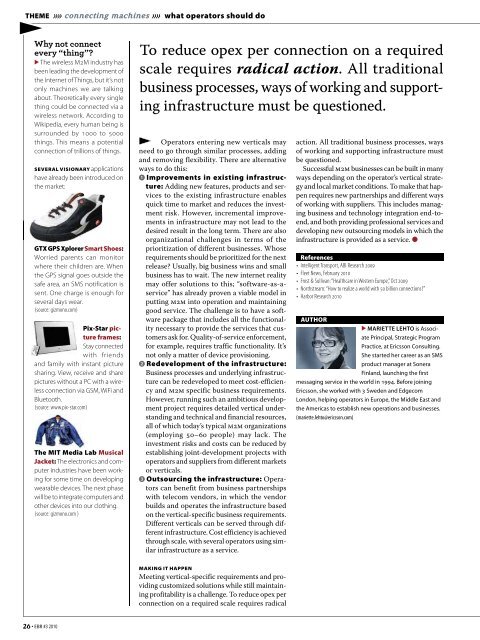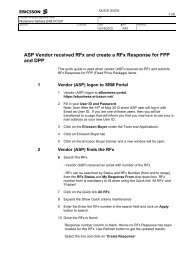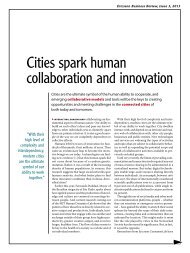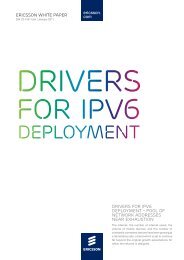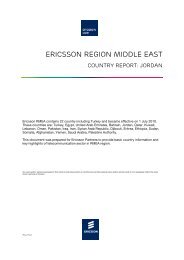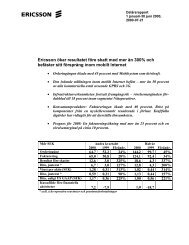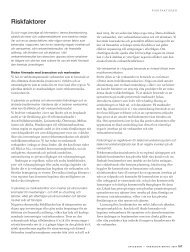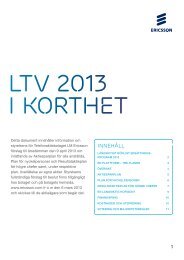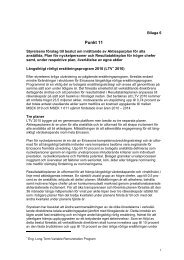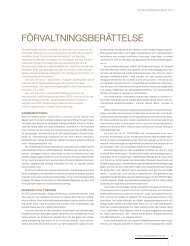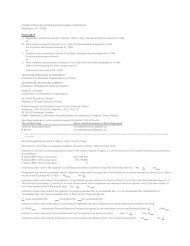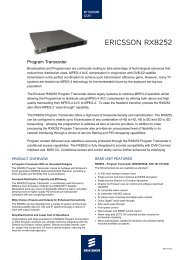Telenor's - Ericsson
Telenor's - Ericsson
Telenor's - Ericsson
- TAGS
- ericsson
- www.ericsson.com
You also want an ePaper? Increase the reach of your titles
YUMPU automatically turns print PDFs into web optimized ePapers that Google loves.
THEME »» connecting machines »» what operators should do<br />
▶<br />
Why not connect<br />
every “thing”?<br />
▶ The wireless M2M industry has<br />
been leading the development of<br />
the Internet of Things, but it’s not<br />
only machines we are talking<br />
about. Theoretically every single<br />
thing could be connected via a<br />
wireless network. According to<br />
Wikipedia, every human being is<br />
surrounded by 1000 to 5000<br />
things. This means a potential<br />
connection of trillions of things.<br />
SEVERAL VISIONARY applications<br />
have already been introduced on<br />
the market:<br />
GTX GPS Xplorer Smart Shoes:<br />
Worried parents can monitor<br />
where their children are. When<br />
the GPS signal goes outside the<br />
safe area, an SMS notification is<br />
sent. One charge is enough for<br />
several days wear.<br />
(source: gizmono.com)<br />
Pix-Star picture<br />
frames:<br />
Stay connected<br />
with friends<br />
and family with instant picture<br />
sharing. View, receive and share<br />
pictures without a PC with a wireless<br />
connection via GSM, WiFi and<br />
Bluetooth.<br />
(source: www.pix-star.com)<br />
The MIT Media Lab Musical<br />
Jacket: The electronics and computer<br />
industries have been working<br />
for some time on developing<br />
wearable devices. The next phase<br />
will be to integrate computers and<br />
other devices into our clothing.<br />
(source: gizmono.com )<br />
26 EBR #3 2010<br />
To reduce opex per connection on a required<br />
scale requires radical action. All traditional<br />
business processes, ways of working and supporting<br />
infrastructure must be questioned.<br />
Operators entering new verticals may<br />
need to go through similar processes, adding<br />
and removing flexibility. There are alternative<br />
ways to do this:<br />
� Improvements in existing infrastructure:<br />
Adding new features, products and services<br />
to the existing infrastructure enables<br />
quick time to market and reduces the investment<br />
risk. However, incremental improvements<br />
in infrastructure may not lead to the<br />
desired result in the long term. There are also<br />
organizational challenges in terms of the<br />
prioritization of different businesses. Whose<br />
requirements should be prioritized for the next<br />
release? Usually, big business wins and small<br />
business has to wait. The new internet reality<br />
may offer solutions to this; “software-as-a-<br />
service” has already proven a viable model in<br />
putting m2m into operation and maintaining<br />
good service. The challenge is to have a software<br />
package that includes all the functionality<br />
necessary to provide the services that customers<br />
ask for. Quality-of-service enforcement,<br />
for example, requires traffic functionality. It’s<br />
not only a matter of device provisioning.<br />
� Redevelopment of the infrastructure:<br />
Business processes and underlying infrastructure<br />
can be redeveloped to meet cost-efficiency<br />
and m2m specific business requirements.<br />
However, running such an ambitious development<br />
project requires detailed vertical understanding<br />
and technical and financial resources,<br />
all of which today’s typical m2m organizations<br />
(employing 50–60 people) may lack. The<br />
investment risks and costs can be reduced by<br />
establishing joint-development projects with<br />
operators and suppliers from different markets<br />
or verticals.<br />
� Outsourcing the infrastructure: Operators<br />
can benefit from business partnerships<br />
with telecom vendors, in which the vendor<br />
builds and operates the infrastructure based<br />
on the vertical-specific business requirements.<br />
Different verticals can be served through different<br />
infrastructure. Cost efficiency is achieved<br />
through scale, with several operators using similar<br />
infrastructure as a service.<br />
MAKING IT HAPPEN<br />
Meeting vertical-specific requirements and providing<br />
customized solutions while still maintaining<br />
profitability is a challenge. To reduce opex per<br />
connection on a required scale requires radical<br />
action. All traditional business processes, ways<br />
of working and supporting infrastructure must<br />
be questioned.<br />
Successful m2m businesses can be built in many<br />
ways depending on the operator’s vertical strategy<br />
and local market conditions. To make that happen<br />
requires new partnerships and different ways<br />
of working with suppliers. This includes managing<br />
business and technology integration end-toend,<br />
and both providing professional services and<br />
developing new outsourcing models in which the<br />
infrastructure is provided as a service. ●<br />
References<br />
• Intelligent Transport, ABI Research 2009<br />
• Fleet News, February 2010<br />
• Frost & Sullivan: “Healthcare in Western Europe,” Oct 2009<br />
• Northstream: “How to realize a world with 50 billion connections?”<br />
• Harbor Research 2010<br />
AUTHOR<br />
▶ MARIETTE LEHTO is Associate<br />
Principal, Strategic Program<br />
Practice, at <strong>Ericsson</strong> Consulting.<br />
She started her career as an SMS<br />
product manager at Sonera<br />
Finland, launching the first<br />
messaging service in the world in 1994. Before joining<br />
<strong>Ericsson</strong>, she worked with 3 Sweden and Edgecom<br />
London, helping operators in Europe, the Middle East and<br />
the Americas to establish new operations and businesses.<br />
(mariette.lehto@ericsson.com)


